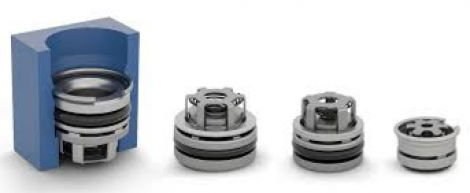- Home » Editorial » Hydraulics
Addressing risks with conventional screw-in check valves

Hydraulic check valves play an essential role in hydraulic systems, ensuring proper flow direction and preventing backflow. According to experts at WEBER-HYDRAULIK, there are notable quality concerns associated with conventional screw-in check valves, particularly when used in aluminium blocks. These issues highlight the potential benefits of switching to pluggable check valves.
Screw-in check valves are among the most common types used in hydraulic systems, but their reliability can be problematic in certain demanding applications. One significant issue is the tendency for these valves to unscrew from their housing. This problem is often caused by a combination of vibrations and differing temperature or expansion coefficients between the valve and the block. Such conditions can weaken the screw connection, leading to potential failure over time. In applications where the hydraulic block experiences structural loads, this unscrewing can exacerbate the issue, resulting in a loss of tightness due to the axially preloaded seal in the bore. Even minor unscrewing can compromise system integrity, with potentially severe consequences for both the hydraulic system and the overall application.
Another challenge with screw-in check valves involves the seals, particularly O rings with low Shore hardness that are commonly used in low-temperature environments. The complex installation process, which requires precise torque to preload the O-ring, carries risks. During mounting, O-rings may be cut or damaged, leading to further issues with system performance.
Contamination from solid particles in hydraulic oil also poses a significant risk, often resulting in hydraulic faults and machine downtime. For example, wear in the form of thread splinters within the aluminium block can create problems with valves that have steel threads. These splinters can obstruct the non-return valve, causing the screw-in torque to be reached prematurely, even if the valve has not been fully screwed in. To address this, complex flushing processes are frequently needed during commissioning to remove these contaminants from the system.
The switch to pluggable check valves offers a solution to many of these problems. By eliminating the need for screw connections and complex sealing mechanisms, pluggable check valves can reduce the risk of unscrewing and damage, leading to improved reliability and easier maintenance. As such, they present a viable alternative to conventional screw-in valves, particularly in demanding applications where system integrity is crucial.
While screw-in check valves are prevalent in hydraulic systems, their limitations in certain scenarios highlight the need for alternatives. Pluggable check valves provide a promising solution, addressing common issues such as unscrewing, seal damage, and contamination, thereby enhancing the overall reliability and performance of hydraulic systems.
https://twitter.com/weber_hydraulik
https://www.linkedin.com/company/weber-hydraulik-gmbh/
-
PPMA 2025
23 September, 2025, 9:30 - 25 September, 2025, 16:00
NEC, Birmingham UK -
Advanced Engineering Show 2025
29 October, 2025, 9:00 - 30 October, 2025, 16:00
NEC, Birmingham UK










